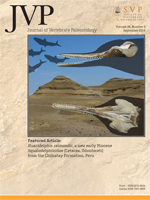Early Miocene deposits from the Domo de Zaza locality, in the south-central Cuban province of Sancti Spiritus, preserve crocodyliform remains, including compressed serrated teeth closely resembling those of South American sebecids. Fragmentary cranial and mandibular material is more difficult to assess. Referral to any other post-Paleogene crocodyliform known from the Western Hemisphere can be ruled out, and phylogenetic analyses are unable to pinpoint its relationships. Similarities can be found with planocraniids, including ventrally oriented and mediolaterally expanded orbital surfaces, but the morphology of the quadrate is inconsistent with a planocraniid affinity. A sebecid in the Miocene of Cuba would be congruent with evidence from other vertebrates suggesting extensive dispersal between the Greater Antilles and South America during the Neogene, and it would be the first Neogene record of the group outside South America. The other crocodyliform may indicate the presence of an endemic West Indian lineage not closely related to any contemporaneous group. It is also consistent with extant Crocodylus arriving in the Neotropics within the past 5–10 million years.
How to translate text using browser tools
1 September 2014
Enigmatic Crocodyliforms from the Early Miocene of Cuba
Christopher A. Brochu,
Osvaldo Jiménez-Vázquez
ACCESS THE FULL ARTICLE





